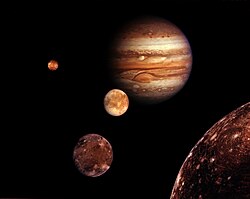- There is also an asteroid called 218 Bianca.
 | |
| Discovery | |
|---|---|
| Discovered by | Bradford A. Smith / Voyager 2 |
| Discovery date | January 23, 1986 |
| Designations | |
Designation | Uranus VIII |
| Pronunciation | /biˈæŋkə/ [1] |
| Adjectives | Biancan [2] |
| Orbital characteristics [3] | |
| 59165.550±0.045 km | |
| Eccentricity | 0.00092 ± 0.000118 |
| 0.434578986 ± 0.000000022 d | |
| Inclination | 0.19308 ± 0.054° (to Uranus's equator) |
| Satellite of | Uranus |
| Physical characteristics | |
| Dimensions | 64 × 46 × 46 km [4] [note 1] |
| ~8400 km2 [a] | |
| Volume | 70900 km3 ± 29.9% [5] |
| Mass | (6.38±1.91)×1016 kg [5] |
Mean density | 0.5–1.2 g/cm3 [6] 0.9 g/cm3 (assumed) [5] |
| synchronous [4] | |
| zero [4] | |
| Albedo | 0.08 ± 0.01 [7] 0.07 [8] [9] |
| 22.52 (at opposition) | |
| |
Bianca is an inner satellite of Uranus. It was discovered from the images taken by Voyager 2 on January 23, 1986, and was given the temporary designation S/1986 U 9. [10] It was named after the sister of Katherine in Shakespeare's play The Taming of the Shrew . It is also designated Uranus VIII. [11]
Contents
Bianca belongs to the Portia group of satellites, which also includes Cressida, Desdemona, Juliet, Portia, Rosalind, Cupid, Belinda, and Perdita. [7] These satellites have similar orbits and photometric properties. [7] Other than its orbit, [3] size of 64 km × 46 km (40 mi × 29 mi), [4] and geometric albedo of 0.08, [7] little is known about it.
In Voyager 2 images Bianca appears as an elongated object, with its major axis pointing towards Uranus. The ratio of axes of the Bianca's prolate spheroid is 0.7±0.2. [4] Its surface is grey in color. [4]

